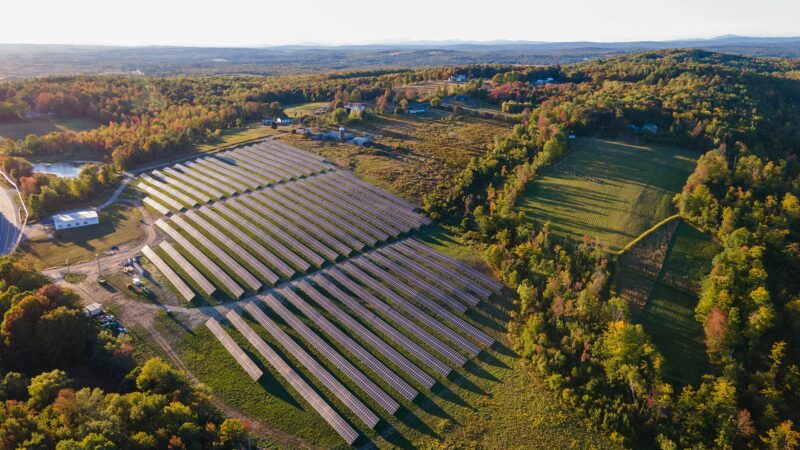Editor’s Note: The following story first appeared in The Maine Monitor’s free environmental newsletter, Climate Monitor, that is delivered to inboxes for free every Friday morning. Sign up for the free newsletter to get more important environmental news from reporter Kate Cough by registering here.
You’ve heard rumblings by now of the tariffs shaking the boots of the solar industry. So what’s all the fuss about, and how will it affect the solar boom in Maine?
All the way back in the Before Times of 2018, when we were wantonly hugging people in restaurants and shaking hands with strangers (!), then-President Trump, following a recommendation of the International Trade Commission, did what he had been threatening to do for awhile and imposed tariffs on a laundry list of products, from washing machines to solar panels.
The additional levies on solar panels were an expansion of policies put in place by the Obama Administration in 2012, after the Department of Commerce found that Chinese companies had been dumping panels in the U.S. at less than fair market value.
The Trump Administration’s tariffs came after two companies, Suniva and SolarWorld, filed petitions with the U.S. International Trade Commission calling for new taxes on imported solar cells and minimum prices for imported solar panels (a panel is an assembly of cells). The new rules imposed tariffs of 30% starting in February 2018, declining 5% each year. They were set to expire this year.
Upwards of 90% of panels in the U.S. are imported, primarily from Vietnam, Malaysia, South Korea and Thailand, and the value of those imports (a close proxy for price) has fallen dramatically in the past decade, from close to $2 per watt in 2010 to $0.38 in 2020, a boon for solar installers and solar power advocates.
Buying panels from Southeast Asia has allowed companies to get around the taxes placed on imports from China, which has long dominated the global solar supply chain, from minerals to manufacturing. The solar installation industry has been critical of excessive tariffs, which it says would nearly double the cost of panels and hamper progress toward climate goals.
Solar manufacturers in the U.S., however, have not fared so well in the solar power market. One of the petitioners in the 2018 case, Georgia-based manufacturer Suniva, filed for bankruptcy a week before it brought forward the petition, having lost $50 million in the span of two years, circumstances it blamed in large part on China and other Asian countries “flooding the U.S. market” with low-cost solar equipment.
The latest dispute came in February after the Biden Administration extended the 2018 tariffs (with some major carve outs), which were set to expire earlier this year. A few days later, several companies filed a petition arguing that the tariffs were being circumvented and undermined by companies importing panels from Southeast Asia that had been constructed with Chinese-made parts.
The petitioners also argued that the evasions have resulted in the use of “At least twice as much international freight as would be used if Chinese producers were not circumventing, and that “Chinese upstream supply is produced by coal-fired power plants and at the expense of human rights through forced labor.”
This move didn’t win the petitioners any fans among installers (The Wall Street Journal recently called Auxin Solar, which filed the petition, the “most-hated solar company in America”). While the Commerce Department investigates, solar development projects, including a number in Maine, have been put on hold.
“It’s just going to make the projects unworkable,” Robert Cleaves of BNRG Dirigo, told Maine Public. An April survey by the Solar Energy Industries Association found that 220 megawatts of capacity and $250 million in investments in Maine are at risk of being delayed or canceled.
Whether or not companies will walk away from their investments remains to be seen. CEO Mamun Rashid of Auxin Solar is skeptical.
“I think the business models will need to be reassessed and will be reassessed,” he told NPR. “No one is going to walk away from hundreds of millions or billion-dollar businesses.”
Officials discuss offshore wind in federal waters
The Bureau of Ocean Energy Management Gulf of Maine Intergovernmental Renewable Energy Task Force, or as I like to call it, the GMIRETF, met for the first time since an announcement last fall by the Biden Administration that it planned to hold an offshore wind lease sale in the Gulf of Maine in mid to late 2024.
The Bureau of Ocean Energy Management is the agency that leases federal waters. The task force is a group of local, state, federal, and tribal representatives from Maine, New Hampshire, and Massachusetts tasked with guiding the Bureau on development in the Gulf of Maine, which, confusingly, extends from Cape Cod to Nova Scotia.
Maine officials have pushed for wind projects to be located in federal rather than state waters. To that end, Governor Janet Mills signed a law last year prohibiting wind energy projects in state waters for a decade, while exploring other opportunities (like a 15-square-mile research array) further offshore.
Maine has a goal of installing 5,000 megawatts of offshore wind by 2030 (although industry experts are skeptical the state could come anywhere close to that figure) and is looking for ways to get involved in the wider wind industry, which officials say will generate $1 trillion in global investment within the next twenty years.
Note that this task force is separate from the Maine Offshore Wind Initiative, a group led by the Governor’s Energy Office. A number of advisory groups have been meeting for months as part of that initiative to talk about issues related to offshore wind in Maine, touching on everything from the environment to the supply chain.
Officials at the full-day GMIRETF meeting had an ambitious agenda, including discussions on wind energy leasing in the Gulf of Maine, the stakeholder engagement process, and state and federal perspectives on offshore wind in the Gulf. You can read more about the meeting and check out materials from the task force’s 2019 meeting here.
To read the full edition of this newsletter, see Climate Monitor: sun and wind.
Kate Cough covers climate change and the environment for The Maine Monitor. Reach her by email with ideas for other stories at kate@themainemonitor.org.





